george washington
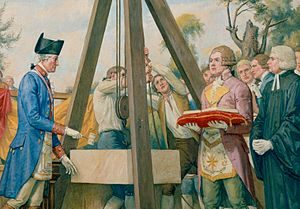
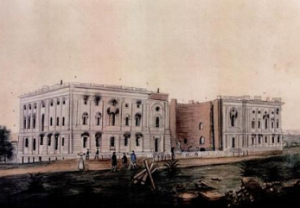 Most people know what the United States Capitol building looks like, and many have seen it, and even been inside it, but I wonder how many people know that is almost wasn’t completed. Yes, you heard me right. I almost wasn’t completed. As a young nation, the United States had no permanent capitol, and Congress met in eight different cities, including Baltimore, New York and Philadelphia, before 1791. In 1790, Congress passed the Residence Act, which gave President Washington the power to select a permanent home for the federal government. The following year, he chose what would become the District of Columbia from land that had been provided by Maryland. Washington picked three commissioners to oversee the capital city’s development and they in turn chose French engineer Pierre Charles L’Enfant to come up with the design. However, L’Enfant clashed with the commissioners and was fired in 1792. A design competition was held, and a Scotsman named William Thornton submitted the winning entry.
Most people know what the United States Capitol building looks like, and many have seen it, and even been inside it, but I wonder how many people know that is almost wasn’t completed. Yes, you heard me right. I almost wasn’t completed. As a young nation, the United States had no permanent capitol, and Congress met in eight different cities, including Baltimore, New York and Philadelphia, before 1791. In 1790, Congress passed the Residence Act, which gave President Washington the power to select a permanent home for the federal government. The following year, he chose what would become the District of Columbia from land that had been provided by Maryland. Washington picked three commissioners to oversee the capital city’s development and they in turn chose French engineer Pierre Charles L’Enfant to come up with the design. However, L’Enfant clashed with the commissioners and was fired in 1792. A design competition was held, and a Scotsman named William Thornton submitted the winning entry.
Then, on this day, September 18, 1793, Washington laid the Capitol’s cornerstone and the lengthy construction process, which would involve a line of project managers and architects, got under way. One would think that is due time, the capitol building would be finished, but in reality, it took almost a century to finish…almost 100 years!! During those years, architects came and went, the British set it on fire, and it was called into use during the Civil War. In 1800, Congress moved into the Capitol’s north wing. In 1807, the House of Representatives moved into the building’s south wing, which was finally finished in 1811. During the War of 1812, the British invaded Washington DC. They set fire to the Capitol on August 24, 1814. Thankfully, a rainstorm saved the building from total destruction. Congress met in nearby temporary quarters from 1815 to 1819. In the early 1850s, work began to expand the Capitol to accommodate the growing number of Congressmen. The Civil War halted construction in 1861 while the Capitol was used by Union troops as a hospital and barracks. Following the war, expansions and modern upgrades to the building continued into the next century.
Today, the Capitol building, with its famous cast-iron dome and important collection of American art, is part of the Capitol Complex, which includes six Congressional office buildings and three Library of Congress buildings, all developed in the 19th and 20th centuries. The Capitol, which is visited by 3 million to 5 million people each 
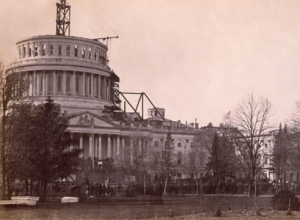 year, has 540 rooms and covers a ground area of about four acres. I’m sure that those who visit the United States Capitol Building probably hear all about it strange past and its construction history, but maybe not. I suppose that it depends on what the tour guide finds interesting. Personally, I like the unusual construction. Thankfully, the United States Capitol did finally get built and has become the beautiful building we know today.
year, has 540 rooms and covers a ground area of about four acres. I’m sure that those who visit the United States Capitol Building probably hear all about it strange past and its construction history, but maybe not. I suppose that it depends on what the tour guide finds interesting. Personally, I like the unusual construction. Thankfully, the United States Capitol did finally get built and has become the beautiful building we know today.
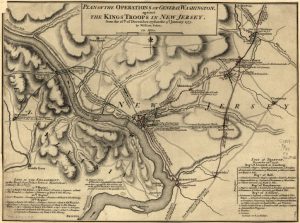 The year was 1776, and it was Christmas Day, but for the men with George Washington, it was not a day of celebration…not exactly anyway. They were in the middle of fighting a war, and the fighting didn’t just stop because it was Christmas, not this year anyway. This was to be an unusual Christmas as far as wartime Christmases went. In 1776, it was difficult to fight a war in the wintertime, because the slower modes of travel. Most times in a war, the armies took the Winter off from warring, but this army was not laying up for the Winter. This war would continue on…no matter what the weather was like.
The year was 1776, and it was Christmas Day, but for the men with George Washington, it was not a day of celebration…not exactly anyway. They were in the middle of fighting a war, and the fighting didn’t just stop because it was Christmas, not this year anyway. This was to be an unusual Christmas as far as wartime Christmases went. In 1776, it was difficult to fight a war in the wintertime, because the slower modes of travel. Most times in a war, the armies took the Winter off from warring, but this army was not laying up for the Winter. This war would continue on…no matter what the weather was like.
Things looked bad that year. The Continental Army had suffered a series of defeats in their battle against the British oppression. After some successful maneuvers, Colonel Henry Knox came to the attention of General George Washington who worked to place him in overall command to the Continental Army. Under his command, the Continentals brought 18 cannon over the river…3 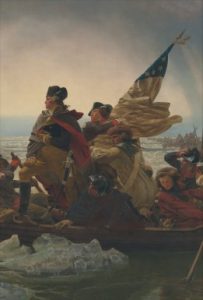 Pounders, 4 Pounders, some 6 Pounders, horses to pull the carriages, and enough ammunition for the coming battle. The 6 Pounders, weighing as much as 1,750 pounds were the most difficult to transport to the far side of the river. But in the end all the trouble of moving this large artillery train to Trenton proved its worth. Knox would place the bulk of his artillery at the top of the town where its fire commanded the center of Trenton.
Pounders, 4 Pounders, some 6 Pounders, horses to pull the carriages, and enough ammunition for the coming battle. The 6 Pounders, weighing as much as 1,750 pounds were the most difficult to transport to the far side of the river. But in the end all the trouble of moving this large artillery train to Trenton proved its worth. Knox would place the bulk of his artillery at the top of the town where its fire commanded the center of Trenton.
The plan devised by Knox and Washington was to conduct a surprise attack upon a Hessian garrison of roughly 1,400 soldiers located in and around Trenton, New Jersey. Washington hoped that a quick victory at Trenton would bolster sagging morale in his army and encourage more men to join the ranks of the Continentals in the coming new year. After several councils of war, General George Washington set the date for the river crossing for Christmas night 1776. It was an unprecedented plan, because the expectation was always that the armies would hold up somewhere for the winter. No one had attacked in winter before, and especially on Christmas. George Washington led 2,400 troops on a daring nighttime crossing of the icy Delaware River. Stealing into New Jersey, on December 26 the Continental forces launched the surprise attack on Trenton.
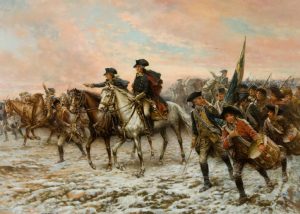 The gamble paid off. Many of the Hessians were still disoriented from the previous night’s holiday bender, and colonial forces defeated them with minimal bloodshed. While Washington had pulled off a shock victory, his army was unequipped to hold the city and he was forced to re-cross the Delaware that same day…with nearly 1,000 Hessian prisoners in tow. Washington would go on to score successive victories at the Battles of the Assunpink Creek and Princeton, and his audacious crossing of the frozen Delaware served as a crucial rallying cry for the beleaguered Continental Army. The Revolutionary War would be won by the Continental Army of course, and the rules of warfare changed forever.
The gamble paid off. Many of the Hessians were still disoriented from the previous night’s holiday bender, and colonial forces defeated them with minimal bloodshed. While Washington had pulled off a shock victory, his army was unequipped to hold the city and he was forced to re-cross the Delaware that same day…with nearly 1,000 Hessian prisoners in tow. Washington would go on to score successive victories at the Battles of the Assunpink Creek and Princeton, and his audacious crossing of the frozen Delaware served as a crucial rallying cry for the beleaguered Continental Army. The Revolutionary War would be won by the Continental Army of course, and the rules of warfare changed forever.

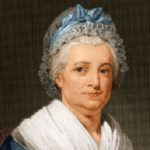 When we think of dinners with the President of the United States, we think of state dinners with tons of security, and massive pre-planning. Presidential dinners have changed distinctly since Washington’s day. The nation was much smaller for sure, and he could easily get together with all of his advisors and Congress in one place, I’m sure. In fact, George Washington was basically in uncharted waters. So, he decided that on Thursday evenings, he would have the brightest minds in the nation over for a casual dinner. At that time the nation’s capitol was still in New York City, so those casual dinners were never held in the White House. George Washington and his family lived in executive mansions in lower Manhattan, which was close to other governmental buildings in that era. While Washington entertained foreign dignitaries and other heads of state at public receptions on Tuesdays and Martha Washington regularly invited guests to their home on Fridays, Thursday evenings were reserved for formal dinners with congressional leaders, their wives and close personal friends of the Washingtons.
When we think of dinners with the President of the United States, we think of state dinners with tons of security, and massive pre-planning. Presidential dinners have changed distinctly since Washington’s day. The nation was much smaller for sure, and he could easily get together with all of his advisors and Congress in one place, I’m sure. In fact, George Washington was basically in uncharted waters. So, he decided that on Thursday evenings, he would have the brightest minds in the nation over for a casual dinner. At that time the nation’s capitol was still in New York City, so those casual dinners were never held in the White House. George Washington and his family lived in executive mansions in lower Manhattan, which was close to other governmental buildings in that era. While Washington entertained foreign dignitaries and other heads of state at public receptions on Tuesdays and Martha Washington regularly invited guests to their home on Fridays, Thursday evenings were reserved for formal dinners with congressional leaders, their wives and close personal friends of the Washingtons.
In reality, these dinners were elaborate affairs. They started promptly at 4:00pm, because Washington refused to wait for latecomers. I guess every president has his own idiosyncrasies. The parties numbered up to two dozen people, gathered around a table set with the Washington family silver and china. Unlike some state dinners, in which the President and his wife occupy the head of the table, Martha Washington preferred to sit in the middle of one side of the long table and President Washington sat directly across from her. The ends of the table were occupied by a secretary to help with the conversation and roast carving. The roast carving was necessary too, because there were a lot of roasts to be carved. The dinners were comprised of three courses, but that did no limit the selection. There would commonly be upwards of twenty different dishes in each course…all of which were brought to the table at the same time.
The various dishes were the finest that New York had to offer, and the guests were lavished with the exquisite meals. Manhattan was in the middle of New York City, but in 1700, it was still quite wild. The island had an assortment of venison, rabbit, and duck that were hunted for food. Oysters were abundant in the Hudson River. Jellies, dried fruits and nuts were served alongside, although you wouldn’t have seen potato or tomato dishes, because those foods were regarded as unfit for humans to eat in those days. Wine was drunk with dinner, although George Washington was said to prefer a tankard of ale over a glass of claret.
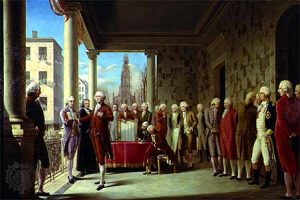
When dinner was over, Washington would raise a toast to the assembly, and then the ladies would retire to Martha’s drawing room for “coffee and civilized conversation.” The gentlemen would remain in the dining room, lingering over cigars and wine, but not for very long. The president only stayed another thirty minutes before joining the women in the drawing room. One of his personal secretaries would stay on in the dining room with the men to preside over political chats for another hour or so, until the company left and the Washingtons’ Thursday dinner was over…until the next week. George Washington passed away on this day, December 14, 1799.
 The Washington cousins, George and William, are cousins of my husband’s family as well, and so their heroism is of interest to me. General George Washington, before he became our first president, was a great general, who played a huge part in making the United States the great nation it is. But, there was another cousin, who played a part…whether George Washington knew that or not, I can’t say, but they did work together to bring a victory in the Revolutionary War that was quite unusual in it’s scope…for that era anyway. That cousin, was Henry Knox, who was born on July 25, 1750, the seventh of ten children of William and Mary Knox.
The Washington cousins, George and William, are cousins of my husband’s family as well, and so their heroism is of interest to me. General George Washington, before he became our first president, was a great general, who played a huge part in making the United States the great nation it is. But, there was another cousin, who played a part…whether George Washington knew that or not, I can’t say, but they did work together to bring a victory in the Revolutionary War that was quite unusual in it’s scope…for that era anyway. That cousin, was Henry Knox, who was born on July 25, 1750, the seventh of ten children of William and Mary Knox.
During the Revolutionary War, it was not unusual for armies to winter somewhere, and then pick up the war in the spring. Because they couldn’t go from place to place as quickly then as they do now, they were left with little choice. Soldiers could die in the frigid conditions, if they didn’t find someplace to wait out the winter months…or so it was thought. Knox was in the military serving with Massachusetts forces in the Army of Observation during the opening days of the Siege of Boston. His abilities soon brought him to the attention of new army commander General George Washington when the general inspected fortifications designed by Knox near Roxbury. The two men quickly became friends. When the army desperately needed artillery, Washington consulted Knox for advice in November 1775. Knox suggested the idea that the 59 cannons recently captured at the fall of forts Ticonderoga and Crown Point in upstate New York  could have a decisive impact on the outcome of the siege. Knox did not have a commission in the army, but John Adams in particular worked in the Second Continental Congress to acquire for him a commission as colonel of the army’s artillery regiment. Washington was so impressed that he put Knox in charge of an expedition to retrieve them even though Knox’s commission had not yet arrived. Reaching Ticonderoga on December 5, 1775, Knox commenced what came to be known as the noble train of artillery, hauling by ox-drawn sled 60 tons of cannons and other armaments across some 300 miles of ice covered rivers and snow draped Berkshire Mountains to the Boston siege camps.
could have a decisive impact on the outcome of the siege. Knox did not have a commission in the army, but John Adams in particular worked in the Second Continental Congress to acquire for him a commission as colonel of the army’s artillery regiment. Washington was so impressed that he put Knox in charge of an expedition to retrieve them even though Knox’s commission had not yet arrived. Reaching Ticonderoga on December 5, 1775, Knox commenced what came to be known as the noble train of artillery, hauling by ox-drawn sled 60 tons of cannons and other armaments across some 300 miles of ice covered rivers and snow draped Berkshire Mountains to the Boston siege camps.
The region they were traveling through to reach Boston was lightly populated and Knox had to overcome difficulties with hiring personnel and obtaining animals. On several occasions cannons crashed through the ice on river crossings, but the detail’s men were always able to recover them. In the end, what Knox had expected to take just two weeks actually took more than six, but he was finally able to report the arrival of the weapons train to Washington on January 27, 1776. The operation was called “one of the most stupendous feats of logistics” of the entire war by historian Victor Brooks. Knox’s effort is commemorated by a series of plaques marking the Henry Knox Trail in New York and Massachusetts.

Upon their arrival in Cambridge the cannons were immediately deployed to fortify the Dorchester Heights recently taken by Washington. So commanding was the new battery over Boston harbor the British withdrew their fleet to Halifax. With the siege ended, Knox undertook the improvement of defenses in Connecticut, Rhode Island, and New York City in anticipation of British attack there. In New York he met Alexander Hamilton, commander of the local artillery. The two men formed a close friendship that lasted until Hamilton’s death in 1804. During his military service Knox also established a close friendship with fellow Massachusetts native Benjamin Lincoln. Henry Knox would go down in history as being one of the great strategists in this nation.
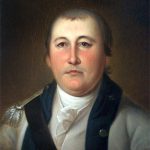 The Revolutionary War is an interesting war in many ways, because while they were limited in the weapons of warfare, they still managed to wage war in a very effective way. Especially in that approximately 12,000 men were killed in action, and the number of men who died from disease, was far more than that. About all the soldiers had to fight with were cannons, and rifles…of the most antiquated sort. Nevertheless, they did the job…most of the time. The biggest problems included a lack of ammunition, and the weight of the cannons.
The Revolutionary War is an interesting war in many ways, because while they were limited in the weapons of warfare, they still managed to wage war in a very effective way. Especially in that approximately 12,000 men were killed in action, and the number of men who died from disease, was far more than that. About all the soldiers had to fight with were cannons, and rifles…of the most antiquated sort. Nevertheless, they did the job…most of the time. The biggest problems included a lack of ammunition, and the weight of the cannons.
The fighting was brutal, with wins and losses on both sides. After nearly a year of the backcountry conflict between Colonel William Washington, who was General George Washington’s second cousin once removed, and the British commander, Lieutenant Colonel Banastre Tarleton, who was infamous for Tarleton’s Quarter, the murder of colonial prisoners of war on May 29, 1780 at Waxhaws, Colonel Washington had retreated to North Carolina the previous October. Orders came from Brigadier General Daniel, commanding Washington to return to the South Carolina theater. Colonel Washington still lacked the proper artillery to properly fight off the Loyalists, who were under the command of Colonel Rowland Rugeley. 
On this day, December 4, 1780, a force of Continental dragoons commanded by Colonel Washington cornered Colonel Rugeley and his followers in Rugeley’s house and barn near Camden, South Carolina. He told his cavalrymen to dismount and surround the barn. While out of Rugeley’s sight, Washington’s men fabricated a pine log to resemble a cannon. This was a Quaker gun trick, named so because the Quakers used it to be intimidating without breaching their pacifist vow of non-violence, and for Colonel William Washington and his men, it worked beautifully. Washington faced the log cannon toward the buildings in which the Loyalists had barricaded themselves and threatened bombardment, if they did not surrender. Shortly after that, Rugeley surrendered his entire force without a single shot being fired. It was an amazing use of strategy, illusion, and forethought on the part of Colonel Washington, and quite likely saved the lives of many of his men.
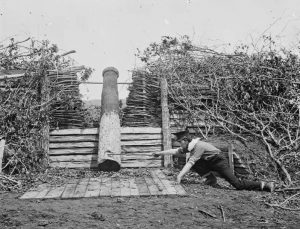
When Lord Charles Cornwallis, commander of the British armies in America, was informed of the pacifist victory, he told Tarleton that Rugeley’s performance ensured he would never rise to the rank of brigadier general. I suppose Cornwallis thought that Tarleton’s men weren’t properly trained. A few weeks later, Tarleton would himself face an even worse humiliation at the hands of General Daniel Morgan during the devastating Battle of Cowpens. The brutal civil war for the hearts and minds of the Carolina backcountry had finally begun to favor the Patriots. Of course, as we now know, the final outcome would be victory and independence for the American Patriots.
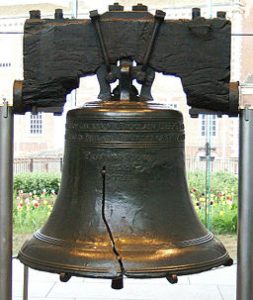 Everyone has heard of the Liberty Bell. The bell was ordered in 1751, to commemorate the 50th anniversary of Pennsylvania’s original constitution. The Pennsylvania Provincial Assembly ordered the 2,000 pound copper and tin bell. The bell was placed in the Pennsylvania State House, which is now known as Independence Hall. The bell rang out summoning citizens to the first public reading of the Declaration of Independence, by Colonel John Nixon. The document was adopted by delegates to the Continental Congress meeting in the State House on July 4th, however, the Liberty Bell, inscribed with the Biblical quotation, “Proclaim Liberty Throughout All the Land unto All the Inhabitants Thereof,” was not rung until the Declaration of Independence was returned from the printer on July 8th.
Everyone has heard of the Liberty Bell. The bell was ordered in 1751, to commemorate the 50th anniversary of Pennsylvania’s original constitution. The Pennsylvania Provincial Assembly ordered the 2,000 pound copper and tin bell. The bell was placed in the Pennsylvania State House, which is now known as Independence Hall. The bell rang out summoning citizens to the first public reading of the Declaration of Independence, by Colonel John Nixon. The document was adopted by delegates to the Continental Congress meeting in the State House on July 4th, however, the Liberty Bell, inscribed with the Biblical quotation, “Proclaim Liberty Throughout All the Land unto All the Inhabitants Thereof,” was not rung until the Declaration of Independence was returned from the printer on July 8th.
The bell was made of inferior materials, and cracked during the first test. It was recast twice and finally hung from the State House steeple in June 1753. The bell was rung on special occasions, such as when King George III ascended to the throne in 1761, and to call the people together to discuss such important things as the controversial Stamp Act of 1765. With the outbreak of the American Revolution in April 1775, the bell was rung to announce the battles of Lexington and Concord. Of course, the most famous time it was rung was July 8, 1776, when it summoned Philadelphia citizens for the first reading of the Declaration of Independence.
When the British were advancing on Philadelphia in the fall of 1777, the bell was removed and hidden in Allentown to protect it from being melted down by the British to be used for cannons. Following the defeat of the British in 1781, the bell was returned to it’s place in Philadelphia which was the nation’s capital from 1790 to 1800. In addition to marking important events, the bell was used as a part of the celebrations such as George Washington’s birthday on February 22, and Independence Day on July 4. In 1839, bell was first given it’s name when it was coined the Liberty Bell in a poem.
As to the crack that finally made the Liberty Bell unsuitable for ringing, there has been some dispute. It was  finally agreed upon that the bell suffered a major break while tolling for the funeral of the chief justice of the United States, John Marshall, in 1835, and in 1846 the crack expanded to its present size while in use to mark Washington’s birthday. After that date, it was decided that the bell was unsuitable for ringing, but it was still ceremoniously tapped on occasion to commemorate important events. On June 6, 1944, when Allied forces invaded France, the sound of the bell’s dulled ring was broadcast by radio across the United States. In 1976, the Liberty Bell was moved to a new pavilion about 100 yards from Independence Hall in preparation for America’s bicentennial celebrations. The Liberty Bell will always be a symbol of patriotism and liberty in my mind.
finally agreed upon that the bell suffered a major break while tolling for the funeral of the chief justice of the United States, John Marshall, in 1835, and in 1846 the crack expanded to its present size while in use to mark Washington’s birthday. After that date, it was decided that the bell was unsuitable for ringing, but it was still ceremoniously tapped on occasion to commemorate important events. On June 6, 1944, when Allied forces invaded France, the sound of the bell’s dulled ring was broadcast by radio across the United States. In 1976, the Liberty Bell was moved to a new pavilion about 100 yards from Independence Hall in preparation for America’s bicentennial celebrations. The Liberty Bell will always be a symbol of patriotism and liberty in my mind.
 The Constitution has been in the news a lot these days, or shall I say, the violation of the Constitution. Sometimes I wonder if the signers of the Constitution would even be able to recognize the nation that they had envisioned when they wrote the Constitution. I happen to think they would not, but then even at the signing of the Constitution there was controversy. In that way, I suppose there would always be those who would do everything in their power to change or even do away with the Constitution. At the time of the Constitutional Convention in Philadelphia, only 38 of the 41 delegates present at its conclusion, agreed to sign the document. There were those, even then, who disagreed with what was laid out there. I suppose that is common in anything in life. Needless to say, it was a hard-won battle to win the ratification by the necessary nine out of thirteen US states in existence at the time.
The Constitution has been in the news a lot these days, or shall I say, the violation of the Constitution. Sometimes I wonder if the signers of the Constitution would even be able to recognize the nation that they had envisioned when they wrote the Constitution. I happen to think they would not, but then even at the signing of the Constitution there was controversy. In that way, I suppose there would always be those who would do everything in their power to change or even do away with the Constitution. At the time of the Constitutional Convention in Philadelphia, only 38 of the 41 delegates present at its conclusion, agreed to sign the document. There were those, even then, who disagreed with what was laid out there. I suppose that is common in anything in life. Needless to say, it was a hard-won battle to win the ratification by the necessary nine out of thirteen US states in existence at the time.
Before the Constitution, the United States was operating under the Articles of Confederation, which was ratified several months before the British surrender at Yorktown in 1781. The Articles of Confederation and Perpetual Union were an agreement among all thirteen original states in the United States of America. Basically it was the first constitution. Even when not yet ratified, the Articles provided a system for the Continental Congress to direct the American Revolutionary War, conduct diplomacy with Europe, and deal with territorial issues and Native American relations, but it was weak in that it didn’t allow for our president, a court system, or taxation, thereby leaving us with a weaker government. Congress was also given no authority to enforce its requests to the states for troops, giving us a weaker military force. Yet, even with the proposed changes, there were those who would disagreed with the proposed new Constitution.
When the Constitutional Convention was convened on May 25, 1787, the plan had been to amend the Articles 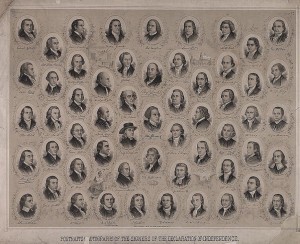 of Confederation, but that plan was quickly set aside in favor of writing a completely new Constitution. The meeting was held in Philadelphia’s Pennsylvania State House. It is now known as Independence Hall. Revolutionary War hero George Washington, a delegate from Virginia was elected as convention president. The debate was heated, but in the end, the delegates came up with a brilliant federal organization that boasted an intricate system of checks and balances. One of the main divisions in the discussions was that the more populated states wanted a state representation in Congress, and the smaller states wanted equal representation. That problem was solved by the Connecticut Compromise, which proposed a two chamber legislature with proportional representation in the lower house known as the House of Representatives and equal representation of the states in the upper house known as the Senate. It seemed a fair way to do it, but there are still those who disagree to this day.
of Confederation, but that plan was quickly set aside in favor of writing a completely new Constitution. The meeting was held in Philadelphia’s Pennsylvania State House. It is now known as Independence Hall. Revolutionary War hero George Washington, a delegate from Virginia was elected as convention president. The debate was heated, but in the end, the delegates came up with a brilliant federal organization that boasted an intricate system of checks and balances. One of the main divisions in the discussions was that the more populated states wanted a state representation in Congress, and the smaller states wanted equal representation. That problem was solved by the Connecticut Compromise, which proposed a two chamber legislature with proportional representation in the lower house known as the House of Representatives and equal representation of the states in the upper house known as the Senate. It seemed a fair way to do it, but there are still those who disagree to this day.
It would seem like they had an instant solution, but that wasn’t so. As dictated by Article VII, the document would not become binding until it was ratified by nine of the 13 states. On December 7, Delaware, Pennsylvania, New Jersey, Georgia, and Connecticut ratified the Constitution in quick succession. Other states, especially Massachusetts, opposed the Constitution, because it failed to reserve undelegated powers to the states and lacked constitutional protection of basic political rights, such as freedom of speech, religion, and the press, which I personally agree with. By February 1788, they had reached a compromise under which Massachusetts and other states would agree to ratify the document and that amendments would immediately be added to provide the protections they proposed. The Constitution was then narrowly ratified in Massachusetts. Maryland and South Carolina quickly followed. On June 21, 1788, New Hampshire became the ninth state to ratify the document, and it was agreed that government under the US Constitution would begin on March 4, 1789. In June, Virginia ratified the Constitution, followed by New York in July. The Constitution was signed on this day, September 17, 1787.
As promised, on September 25, 1789, the first Congress of the United States adopted 12 amendments to the 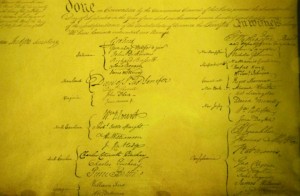 US Constitution, called the Bill of Rights. The Bill of Rights was then sent to the states for ratification. Ten of these amendments were ratified in 1791. In November 1789, North Carolina became the 12th state to ratify the US Constitution. Rhode Island, which opposed federal control of currency and was critical of compromise on the issue of slavery, resisted ratifying the Constitution until the US government threatened to sever commercial relations with the state. On May 29, 1790, Rhode Island voted by two votes to ratify the document, and the last of the original 13 colonies joined the United States. Today, the US Constitution is the oldest written constitution in operation in the world. That should say something, and it should be reason to protect it.
US Constitution, called the Bill of Rights. The Bill of Rights was then sent to the states for ratification. Ten of these amendments were ratified in 1791. In November 1789, North Carolina became the 12th state to ratify the US Constitution. Rhode Island, which opposed federal control of currency and was critical of compromise on the issue of slavery, resisted ratifying the Constitution until the US government threatened to sever commercial relations with the state. On May 29, 1790, Rhode Island voted by two votes to ratify the document, and the last of the original 13 colonies joined the United States. Today, the US Constitution is the oldest written constitution in operation in the world. That should say something, and it should be reason to protect it.
 It’s tradition…looking at your life on Thanksgiving Day, to give thanks for the many blessings that you have received over the year, and the years past. We take stock of everything. The sad things are set aside for review on another day, and we focus on our family, friends, homes, and jobs. And we look to the future and what it promises to bring for us. It isn’t all about things, and in fact, things are often the furthest things from our minds. We are much more focused on our loved ones. Of course, this isn’t the only day we give thanks for our loved ones, nor should it be, but sometimes we find ourselves so preoccupied with our daily lives, that we don’t really notice the blessings that are all around us every day.
It’s tradition…looking at your life on Thanksgiving Day, to give thanks for the many blessings that you have received over the year, and the years past. We take stock of everything. The sad things are set aside for review on another day, and we focus on our family, friends, homes, and jobs. And we look to the future and what it promises to bring for us. It isn’t all about things, and in fact, things are often the furthest things from our minds. We are much more focused on our loved ones. Of course, this isn’t the only day we give thanks for our loved ones, nor should it be, but sometimes we find ourselves so preoccupied with our daily lives, that we don’t really notice the blessings that are all around us every day.
This tradition was felt to be so important, that on October 3, 1783, President George Washington issued a proclamation making the 26th day of November as a national day of prayer and thanksgiving…a day to give thanks to Almighty God with grateful hearts for all He has done for us. While the date has been changed to the 4th Thursday of November now, the tradition has remained intact. Somehow though, many people have forgotten the prayer and thanksgiving part of the day, and remember only the food part of the day. There is nothing wrong with feasting…in fact God set aside feast days for His people too, but we must remember that the feast part of the day is supposed to coincide with the prayer and thanksgiving part of the day.
It is my belief that most people are thankful for what they have, but there is a difference between being thankful for things, and giving thanks for things. I believe that difference is acknowledging the one who gave all these things to you…God. I 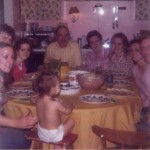 suppose that people who don’t believe in God would see no reason to be thankful to Him, but for me, with my deep faith in God, blessing couldn’t come from anywhere else. God loves me and He is the one who blesses me. Therefore, it is to Him…Almighty God that I give thanks on this Thanksgiving Day. I, like so many other people, neglect the need to thank God in the way that I really should, and maybe having a national day of Thanksgiving, will give us all the opportunity to step back from our busy lives and take a good look at all we have been blessed with. And maybe we can all take a few minutes out of this day to acknowledge God’s grace and loving kindness toward us…and give Him thanks for all he does for us. Happy Thanksgiving to all…and thanks be to God for His loving kindness and all the blessing He has given me and my family.
suppose that people who don’t believe in God would see no reason to be thankful to Him, but for me, with my deep faith in God, blessing couldn’t come from anywhere else. God loves me and He is the one who blesses me. Therefore, it is to Him…Almighty God that I give thanks on this Thanksgiving Day. I, like so many other people, neglect the need to thank God in the way that I really should, and maybe having a national day of Thanksgiving, will give us all the opportunity to step back from our busy lives and take a good look at all we have been blessed with. And maybe we can all take a few minutes out of this day to acknowledge God’s grace and loving kindness toward us…and give Him thanks for all he does for us. Happy Thanksgiving to all…and thanks be to God for His loving kindness and all the blessing He has given me and my family.
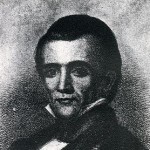
 I have always known of my family’s relationship to Princess Diana, and I also knew about the Knox family’s relationship to James Knox Polk, who is Bob’s 2nd cousin 5 times removed, but in more recent years I have come across, or as one family member put it, tripped over a line of presidents on my side of the family as well as Bob’s. It seems that both of us are related George HW Bush, my 15th cousin once removed, and George W Bush, who is my 15th cousin 2 times removed. We are also related to, although in a roundabout way, Andrew Jackson, the husband of aunt of wife of 1st cousin 6x removed of my husband, Bob…I know, that one is a little bit complicated.
I have always known of my family’s relationship to Princess Diana, and I also knew about the Knox family’s relationship to James Knox Polk, who is Bob’s 2nd cousin 5 times removed, but in more recent years I have come across, or as one family member put it, tripped over a line of presidents on my side of the family as well as Bob’s. It seems that both of us are related George HW Bush, my 15th cousin once removed, and George W Bush, who is my 15th cousin 2 times removed. We are also related to, although in a roundabout way, Andrew Jackson, the husband of aunt of wife of 1st cousin 6x removed of my husband, Bob…I know, that one is a little bit complicated.
I did not know of the Spencer connection to, Calvin Coolidge, Franklin Delano Roosevelt, and George Washington. I also did not know of the Knox connection to the family history to Kentucky Frontiersman Daniel Boone, Benjamin Harrison, a signer of the Declaration of Independence; his son, William Henry Harrison, 9th President of the United States; his great-grandson, Benjamin Harrison, 23rd President of the United States and…President George Washington. At this point, I don’t know at what level we are related to these, but I am finding out that Bob’s family history and my family history are intermingled in several areas. Now that I have some of this information, I look forward to putting these people into my family history, so I can find out how we are connected and who else might be in the family.
I have also found out that on the Spencer side of the family, Henry and Isabella Lincoln Spencer, who lived in the 1400’s, had a very large influence on the United States, as well as England, through their offspring. And, I have found out that John and Jean Gracy Knox, who lived in the 1700’s, also had a large influence in American history through their offspring. It is very strange to me to look at the people in history, knowing that at the time they had children, they had no idea what impact those children and their descendants would have on the world. To be an American president or a signer of the Declaration of Independence, made these men very well known throughout history. Even a frontiersman from Kentucky who probably never gave any thought to what the future of our nation might be at the time he was doing his part to go down in history, has managed to become an endeared character in all the history books, as well as, in television shows and movies. Who would have ever thought that could happen?
It’s odd to think that, depending on what we do with our lives, any one of us could stand out in the history of the nation and the world. Little did anyone think of the future when they began whatever cause they held close to their heart, and yet, just a short time down the road, they have become a household name, written in every history book, with parks, schools, museums, and airports, named after them. I wonder if they had any inkling just how big they were going to become. It is mind boggling just to think back on it now, and I’m not them. Of course, they didn’t really know how big they would be at the time they were becoming so big. Still, 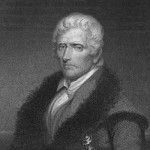
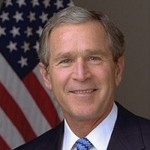 the presidents had to have known at the time they were elected that they had joined an elite group of men, and that would never change from that point on. Good or bad, right or wrong, the decisions they made from the first day of their presidency to the last, would be on record as either a testament or detriment to the man. I think that, in itself, would be a daunting thought, but in reality, they couldn’t think about that much when the decisions that affect a nation are in their hands. Just like their predecessors, they are a part of a long line of presidents, and some of them, are a part of my family.
the presidents had to have known at the time they were elected that they had joined an elite group of men, and that would never change from that point on. Good or bad, right or wrong, the decisions they made from the first day of their presidency to the last, would be on record as either a testament or detriment to the man. I think that, in itself, would be a daunting thought, but in reality, they couldn’t think about that much when the decisions that affect a nation are in their hands. Just like their predecessors, they are a part of a long line of presidents, and some of them, are a part of my family.

